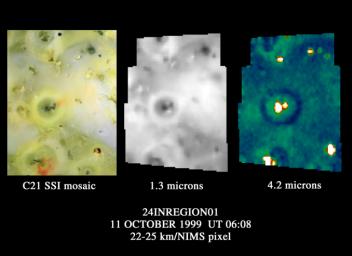
|
Io’s Prometheus Regions as Viewed by Galileo NIMS
- Click the image above for a larger view
- Full-Res JPEG (1157 x 841) (76.8 kB)
- Full-Res TIFF (1157 x 841) (870.0 kB)
Caption:
This image shows the region around the Prometheus volcano on Jupiter's moon Io. It was observed by the near-infrared mapping spectrometer on NASA's Galileo spacecraft as it was flying away from a close approach to Io. The area shown is about 1.6 million square kilometers (about 600,000 square miles), roughly the size of the "four corner states" (Arizona, New Mexico, Utah, and Colorado).
The spectrometer instrument detects heat emitted by objects that is not visible to the naked eye. The image on the left was taken by Galileo's camera in visible wavelengths; it shows the context for the center and right images. The center and right images show spectrometer data at wavelengths of 1.3 and 4.2 microns respectively. The spectrometer can determine surface composition by measuring the spectrum of reflected sunlight, and can measure thermal emission from Io's hot lava.
Prometheus is seen near the center of the three images. The image in the center, taken by the spectrometer at 1.3 microns, shows variations in light and dark surface materials, which result from variations in composition. The spectrometer thermal map (image on right) at 4.2 microns shows where the most heat is being produced from active volcanoes on the surface. The bright colors are used to indicate hot areas. Ten active volcanic regions(hot spots) are seen in this image. Four faint hot spots near the top of the image were not known to be active volcanoes before this image was acquired. All the hot spots correspond to dark areas in the visible wavelengths. This indicates that where the camera shows dark regions on Io, the infrared observations reveal that those regions contain hot lava.
A distinct, dark ring can be seen clearly in the spectrometer's 4.2-micron map. The ring indicates a higher local concentration of sulfur dioxide, which appears dark at this wavelength. The dark ring is slightly larger in diameter than the bright ring that can be seen in the visible light camera image and the spectrometer's 1.3-micron image. This contradicts a previous belief that regions rich in sulfur dioxide on Io's surface appear white at visible wavelengths. The Prometheus ring is believed to be composed of fallout from the Prometheus volcanic plume. It is possible that both sulfur and sulfur dioxide are present in the plume, and that the bright white ring represents mostly sulfur deposits. Because sulfur dioxide is more volatile than sulfur, it may not condense and stick to the surface as close to the volcanic vent as sulfur does.
Background Info:
Launched in October 1989, Galileo entered orbit around Jupiter on December 7, 1995 on a mission to study the giant planet, its largest moons and its magnetic environment. JPL manages the mission for NASA's Office of Space Science, Washington, DC. JPL is a division of the California Institute of Technology, Pasadena, CA.
This image and other images and data received from Galileo are posted on the World Wide Web, on the Galileo mission home page at http://solarsystem.nasa.gov/galileo/ . Background information and educational context for the images can be found at http://galileo.jpl.nasa.gov/gallery/io.cfm .
Cataloging Keywords:
| Name | Value | Additional Values |
|---|---|---|
| Target | Io | Jupiter |
| System | Jupiter | |
| Target Type | Satellite | Planet |
| Mission | Galileo | |
| Instrument Host | Galileo Orbiter | |
| Host Type | Orbiter | |
| Instrument | Near-Infrared Mapping Spectrometer (NIMS) | |
| Detector | ||
| Extra Keywords | Color, Infrared, Magnetosphere, Map, Plume, Thermal, Volcano | |
| Acquisition Date | ||
| Release Date | 1999-11-19 | |
| Date in Caption | ||
| Image Credit | NASA/JPL | |
| Source | photojournal.jpl.nasa.gov/catalog/PIA02515 | |
| Identifier | PIA02515 | |
